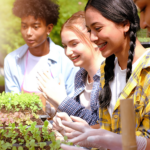My parents, both teachers, knew the value of learning and signed me and my siblings for every opportunity available beyond the school day. In 3rd-6th grades, my scores in Language Arts placed* me in a category of gifted and talented students, with access to unique learning opportunities. I participated in everything I could, including a French class, Junior Great Books, and Music Appreciation, which focused on different forms and styles of music, very little of which I can remember now.
I do recall a certain piece of music as a touchstone in that memory: Mussorgsky’s Pictures at an Exhibition. This piece has 10 movements (or sections), concluding with the 10th one: The Great Gate of Kyiv (officially, The Bogatyr Gates). Our class was able to hear – live – some of the pieces we’d studied. In my mind’s eye, I see my wide-eyed 9 years old self sitting in Orchestra Hall and listening to The Great Gate of Kyiv performed live by the Minnesota Orchestra.
As a child, I was given the opportunity to experience that piece, and years later, I can still remember the awe I felt when I saw it performed live. While this is nothing of specific consequence, it’s evidence of learning that sticks- in my case, for 40 years. When Russia invaded Ukraine, and reporters began pronouncing “Kiev” as Keev, I recalled Pictures at an Exhibition, and that 10th and final movement. It connects me to Ukraine and their fight for independence. It connects me to classical music, as one of the few pieces I can identify. Just now, I walked by my husband’s office, where he listens to classical music as he works. Movement 10 was playing, and my memories and connections to The Great Gate of Kyiv returned in a moment. The piece connects me to a happy childhood memory – of learning.
Why does this matter now? In teaching, you never know what sticks with your students. The opportunity to explore classical music stuck with me, and as I aged, drew connections to the world for continued learning. I could never have known the power of that learning- that small speck of a song in a universe of music. We can deepen students’ learning through various forms of instruction to help that learning stick, as I was able to experience with prior study, an in-person concert, and discussion about the performance. This is part of the best practices of the Science of Learning. Perhaps it’s what you say, how you look at a student, or respond to their work that will stick. Maybe they remember something about an acronym you use to solve math problems, or a song you sing about the elements, or comparisons to the bigger picture.
But that’s the thing, isn’t it? We don’t know the connections we help students to forge. But we do it anyway, and we work to help each student find their connections, apply their learning, or create lasting memories. Our students learn from us, and their world gets bigger. This impact is just one of many benefits of teaching: our part in creating a better world. And you are imperative to that effort.
Welcome back. You’ve got this. Make your students’ learning stick.
*I grew up in the 1970s, where the opportunities were limited to those who understood well how to take and succeed at Standard Achievement Tests. I look back at this privilege through educator lenses now, and know all students, especially those who struggle in a traditional structure, desperately need outside learning opportunities to grow. So many of my classmates would have thrived with the chance to learn differently.






